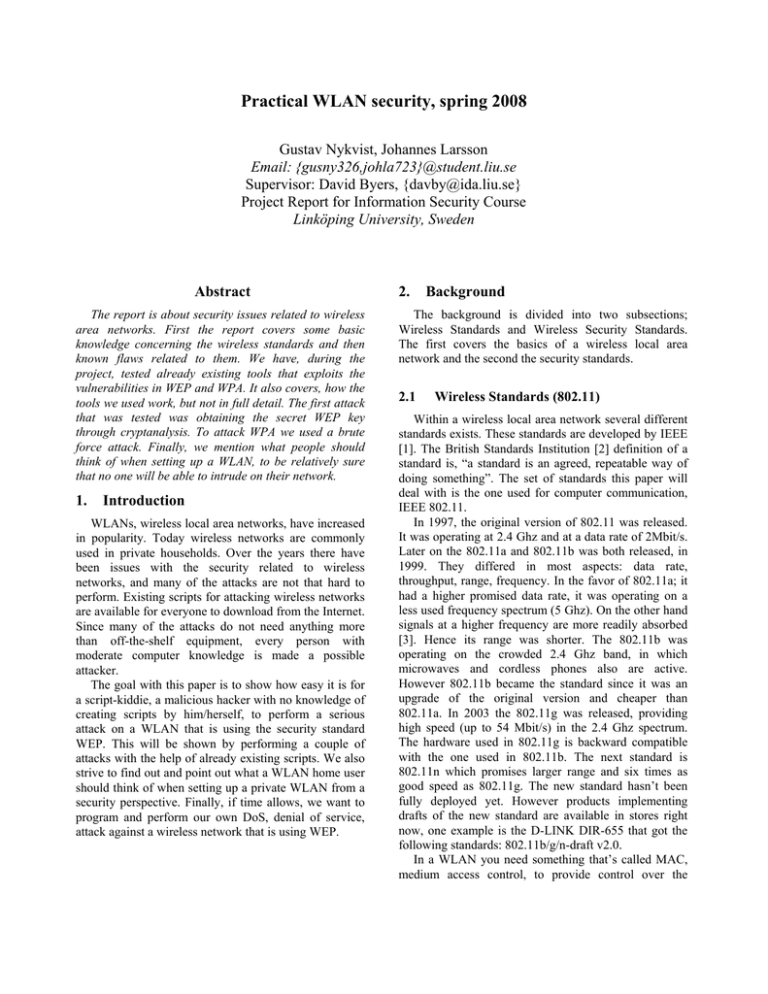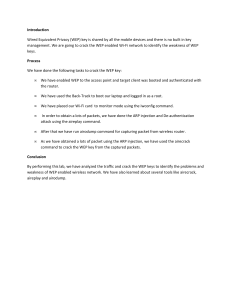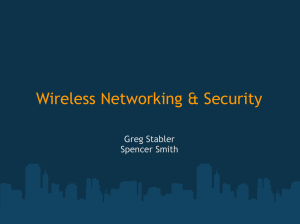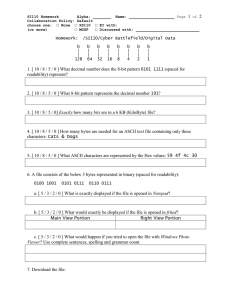Practical WLAN security, spring 2008
advertisement

Practical WLAN security, spring 2008
Gustav Nykvist, Johannes Larsson
Email: {gusny326,johla723}@student.liu.se
Supervisor: David Byers, {davby@ida.liu.se}
Project Report for Information Security Course
Linköping University, Sweden
Abstract
The report is about security issues related to wireless
area networks. First the report covers some basic
knowledge concerning the wireless standards and then
known flaws related to them. We have, during the
project, tested already existing tools that exploits the
vulnerabilities in WEP and WPA. It also covers, how the
tools we used work, but not in full detail. The first attack
that was tested was obtaining the secret WEP key
through cryptanalysis. To attack WPA we used a brute
force attack. Finally, we mention what people should
think of when setting up a WLAN, to be relatively sure
that no one will be able to intrude on their network.
1.
Introduction
WLANs, wireless local area networks, have increased
in popularity. Today wireless networks are commonly
used in private households. Over the years there have
been issues with the security related to wireless
networks, and many of the attacks are not that hard to
perform. Existing scripts for attacking wireless networks
are available for everyone to download from the Internet.
Since many of the attacks do not need anything more
than off-the-shelf equipment, every person with
moderate computer knowledge is made a possible
attacker.
The goal with this paper is to show how easy it is for
a script-kiddie, a malicious hacker with no knowledge of
creating scripts by him/herself, to perform a serious
attack on a WLAN that is using the security standard
WEP. This will be shown by performing a couple of
attacks with the help of already existing scripts. We also
strive to find out and point out what a WLAN home user
should think of when setting up a private WLAN from a
security perspective. Finally, if time allows, we want to
program and perform our own DoS, denial of service,
attack against a wireless network that is using WEP.
2.
Background
The background is divided into two subsections;
Wireless Standards and Wireless Security Standards.
The first covers the basics of a wireless local area
network and the second the security standards.
2.1
Wireless Standards (802.11)
Within a wireless local area network several different
standards exists. These standards are developed by IEEE
[1]. The British Standards Institution [2] definition of a
standard is, “a standard is an agreed, repeatable way of
doing something”. The set of standards this paper will
deal with is the one used for computer communication,
IEEE 802.11.
In 1997, the original version of 802.11 was released.
It was operating at 2.4 Ghz and at a data rate of 2Mbit/s.
Later on the 802.11a and 802.11b was both released, in
1999. They differed in most aspects: data rate,
throughput, range, frequency. In the favor of 802.11a; it
had a higher promised data rate, it was operating on a
less used frequency spectrum (5 Ghz). On the other hand
signals at a higher frequency are more readily absorbed
[3]. Hence its range was shorter. The 802.11b was
operating on the crowded 2.4 Ghz band, in which
microwaves and cordless phones also are active.
However 802.11b became the standard since it was an
upgrade of the original version and cheaper than
802.11a. In 2003 the 802.11g was released, providing
high speed (up to 54 Mbit/s) in the 2.4 Ghz spectrum.
The hardware used in 802.11g is backward compatible
with the one used in 802.11b. The next standard is
802.11n which promises larger range and six times as
good speed as 802.11g. The new standard hasn’t been
fully deployed yet. However products implementing
drafts of the new standard are available in stores right
now, one example is the D-LINK DIR-655 that got the
following standards: 802.11b/g/n-draft v2.0.
In a WLAN you need something that’s called MAC,
medium access control, to provide control over the
medium, which in a WLAN is the radio spectrum. The
main reason for using MAC is to the decrease the
number of collisions, resulting in a higher throughput.
The standard MAC in 802.11 is CSMA/CA, carrier sense
multiple access with collision avoidance. It’s basically
about listening if anyone is sending, if so wait a random
amount of time and check again, else just start sending.
Another option is to use different types of frames, RTS
(request to send) and CTS (clear to send).
As David Byers [4] mentioned in his slides, “Security
was a top concern when IEEE 802.11 was defined. The
standard includes an optional protocol called WEP that is
designed to provide the same level of security as a wired
network”. More information about WEP and the other
standards will be covered later on in the paper.
2.1.1
Architecture
All components able to communicate over the
wireless medium are called stations. They all got a
unique id called MAC address. A typical example of a
station is a mobile device, such as a laptop. The principal
component of a WLAN is the basic service set, BSS and
the access point, AP. A BSS is the service that an AP
provides, the AP itself is a station that is wired, often to
the Internet. A WLAN that deploys access points is
referred to as an infrastructure network. But of course
there are WLANs without any access points, they are
called ad-hoc networks. The idea is to connect two or
more stations as they need to communicate, forming a
network of their own, but with no connection to the
outside world. No Internet.
In an infrastructure network stations need to associate
to the AP before they can start sending or receiving data.
This requires that the access point is configured with a
name, also referred to as Service Set Identifier, SSID.
These names are viewable when browsing wireless
networks on a regular computer with a wireless network
interface card, NIC. When a station is associating it can
be described as creating a virtual wire between itself and
the AP. In 802.11 access points periodically sends
announcements, also referred to as beacon frames,
including the APs SSID and MAC address. Clients listen
for these announcements to discover access points, it’s
called passive scanning. But they can also probe for
them by broadcasting a request, this is referred to as
active scanning. When the client is done it unplug the
virtual wire by disassociating.
2.1.2
Frame
Frames are data packets of a fixed size encoded by the
link layer protocol, in this case 802.11. Every frame got
a control field that consists of much information: the
version of the 802.11 protocol, the type of the frame, a
more fragment field, if WEP is enabled or not and many
more. All frames also got four address fields, three of
them are needed to send a network-layer datagram to an
AP and onwards to a router interface. The last one is
used in ad hoc mode. There are also a frame sequence
field to avoid receiving duplicates and a duration field
which describes how long you want to reserve a channel.
Reserving channels is used when sending data, RTS
(request to send) and CTS (clear to send) frames. These
frames accompanied with the ACK (acknowledge) frame
is all referred to as control frames.
Another type of a frame is the management frames.
They are used in order to establish and maintain
communication. Different types of them are:
• Authentication frame, are used in the context
of access points deciding if to accept or
reject setting up communication. In an open
system the connecting station just sends one
authentication frame and the AP answers by
sending one back, declaring if it accepts or
rejects.
As opposite to the open system there are
those with a shared key. Here the AP
initializes a challenge as its first step after it
has received an authentication frame from
the station. It then has to encrypt it with its
shared key and send it back to the AP. The
access point then encrypts it and compares
the result with the correct key it got stored.
Depending on the result it decides if to
accept or reject.
• De-authentication frame, is the opposite,
used when to terminate a communication.
• Association
frame
requests,
enables
synchronization and helps allocating
resources for the station, that’s sending it to
the AP.
• Disassociation frames, are also sent by the
station. It is the nice way to end an
association, as a result the access point can
relinquish resources that was previously used
by the station.
• Beacon frames are an announcement of the
existence of the AP. These are broadcasted
periodically. A broadcast is referred to as
sending to all, in this context it will only be
those that are within range. The frame
consists of the SSID of the AP and some
other parameters.
• Probe requests are sent by the station to find
access points it is familiar with.
At last, there is one last type, the data frame. It’s used
when transporting data. [10]
2.2
Wireless Security Standards (802.11i)
This section covers the three Security standards
briefly.
2.2.1
WEP
Wireless equivalent privacy protects the link-level
data during transmission and is used in 802.11 networks.
The WEP security goals are to enforce confidentiality,
access control and data integrity. Confidentiality refers
to protecting the communication from eavesdropping.
Access control refers to protecting the access to the
network and data integrity refers to protecting from
tampering on transmitted packages. To achieve the
security goals the protocol makes use of different
security mechanisms, which will be described briefly.
Checksumming, first an integrity checksum c(M) is
computed on the message M. After that the two are
concatenated to obtain the plaintext P=<M,c(M)>. This
will be used as the input for the second stage. During the
second stage, encryption, the plaintext P is encrypted
using the algorithm RC4 (which is implemented in a
non-standard way). An initiation vector (IV) v is chosen.
RC4 generates, as a function of the pre-shared key k and
the IV v, a keystream. A keystream is in example a
sequence of pseudorandom bytes. The keystream is
denoted RC4(v,k). After this the plaintext is added with
exclusive-or to the keystream to obtain the ciphertext.
This is denoted C=XOR(P,RC4(v,k)). Finally, the IV
and the ciphertext are transmitted over the radio link.
A → B: v,(XOR(P,RC4(v,k)) where P=<M,c(M)>, is
a symbolical representation of the checksumming,
encryption and transmission. The recipient simply
reversers the encryption process when he wants to
decrypt a frame protected by WEP. Symbolically this
can
be
written
P
=
XOR(C,RC4(v,k) =
XOR(XOR(P,RC4(v,k)),RC4(v,k) = P. To verify the
checksum on the decrypted plaintext P the recipient
splits it into the form the form <M,c>, re-computes the
checksum c(M), and checks that it matches the received
checksum c [5].
2.2.2
WPA
WiFi protected access, WPA, has the same purpose as
WEP. To meet some of the security issues in WEP,
WPA uses WEP but with a new front-end called TKIP,
temporal key integrity protocol. WPA uses the RC4
stream cipher algorithm, the same that is used in WEP.
The intention with TKIP was that it should be an interim
solution, and that it should work with already deployed
hardware. This imposes some constraints. Allow
deployed systems software or firmware to be
upgradeable. Current WEP hardware implementation
should be allowed to remain unchanged. Finally,
minimize performance degradation imposed by the fixes.
To address the known flaws in the WEP protocol TKIP
uses a set of algorithms. To defeat forgeries there is a
message integrity code, MIC, referred to as Michael. To
defeat replay attacks there is a packet sequencing
discipline. And to prevent cryptanalysis attacks there is a
per-packet key mixing function. The MIC, packet
sequencing and per-packet key mixing will be described
briefly. The Michael algorithm calculates the keyed
function and then sends the result as a tag to the data to
the receiver. The receiver re-computes the value and
compares the values. If the values match the receiver
assumes that the data is authentic and if they don’t the
receiver rejects the data. Michael partitions a 64-bit key
into 32-bit blocks. After this, shifts and exclusive ORs
are used to process the two 32-bit blocks in to two 32-bit
registers. The two 32-bit registers will represent the
result, a 64-bit authentication tag. The level of security
of the MIC is measured in bits.
TKIP also mandates countermeasures because
Michael is too weak to stand alone. If a MIC validation
error is discovered TKIP requires a rekey. There is a
maximum limit for rekeying, once per minute.
Packet sequencing is used to protect against replay
attacks. WEP is extended by TKIP to use a 48-bit
sequence number. However, because of existing
implementation constraints it associates the sequence
number with the encryption key instead of the MIC key.
TKIP then mixes the sequence number into the into the
encryption key, and encrypts the WEP ICV and the MIC.
A replay attack will be translated into ICV or MIC
failures. Per packet key-mixing is used to defend against
cryptanalysis attacks. TKIP uses a new per-packet
encryption key construction that is based on a mixing
function. The base key, transmitter MAC address and
packet sequence number are the inputs to the mixing
function and the output is a new packet WEP key [6].
2.2.3
802.11i / WPA2 / RSN
A long awaited security standard for wireless
networks, designed without any restriction of being
backwards compatible with old hardware. This is
announced to be a long-term solution. Instead of using
RC4 like WEP and WPA do, it uses AES in counter
mode to make the block cipher work as a stream cipher.
This assures 802.11i to provide confidentiality, integrity
and data origin. It also got:
• Longer keys than WEP do
• A new integrity check
• Replay protection
WPA2 can run in two different modes, one for home
and small offices, this referred to as WPA-PSK, preshared key mode. When running in this mode there is no
need for an 802.1X authentication server. The only thing
a user must supply to access the network is a passphrase,
these consist of 8 to 63 ASCII characters. It’s also
possible to use a passphrase of 64 hexadecimal numbers.
These passphrases must be known by the access point
and are stored on them. They are also usually stored on
the computer in the operating system to increase the
usability, no one wants to re-enter the passphrase each
time your station re-associates.
The other mode WPA2 can run in is the Enterprise
mode. This mode uses an 802.1X authentication server.
The 802.1X ensures that a station must be authenticated,
in order to gain access to other LAN resources. As the
Wi-Fi Alliance mentions “Hackers can break encryption
codes by intercepting and analyzing large amounts of
data, but breaking codes takes time” [9]. This can be
prevented by changing codes every five minutes or so,
making sure that the codes the hacker breaks are useless.
The 802.1X changes the codes automatically.
3.
Security
This section will cover the security aspects.
3.1
Flaws in Wireless Standards
One problem here is that all peripherals operating on
the same frequency as the WLAN will interfere it, as a
result compromising the availability. As mentioned
before microwaves and cordless telephones operate on
the 2.4 Ghz ISM band, and by using these you will suffer
from lower or no performance on your WiFi network.
There are many guides on the Internet describing how to
build your own Radio Frequency (RF) Jamming device.
Another problem is the range, which is specified
indoors with regular antennas. So by using larger and
more expensive antennas you can increase the range
significantly. One example is using a WiFi yagi rifle
which can increase the range from the specified 100 m to
16 km [4]. This proves the point that you never should
use the range as security measure.
3.1.1
Architecture
Since all stations got a unique id, the MAC address, it
should be very hard to falsify who you are. However it’s
not. Today it’s possible and easy to change the MAC
address on most hardware, also known as MAC
spoofing.
3.1.2
Frames
Within the security standards we are covering in this
paper the only frame that is protected is the data frame.
Hence both the control and management frame are
unprotected, which in fact is the same as being
transmitted in the clear.
3.2
Flaws in Wireless Security Standards
The standards and the problems related to them.
3.2.1
WEP
WEP fails to meet all of the three security goals.
Since WEP uses a single pre-shared key. There is often a
device that stores the key, and if that device is
compromised or lost the key must be changed. Since
there is no key management protocol in WEP, changing
key can take a lot of time. However, this kind of problem
is often ignored. The threat that is considered as the most
serious in practice is that the key can be retrieved
through cryptanalysis. WEP uses the RC4 algorithm, but
it is implemented in a non-standard way. The RC4 perpacket key is created by concatenating a base key with a
24-bit per-packet nonce, called the WEP IV. If an
eavesdropper can obtain several million encrypted
packets where the first part of the plaintext is known it is
possible for the eavesdropper to deduce the RC4 key.
This is possible by exploiting the properties of the key
schedule. Since the attack only requires off-the-shelf
software and hardware and is purely passive it is a
dangerous threat.
Since the cryptanalysis attack perhaps is the most
serious threat against WEP, it is worth mentioning some
history behind it and briefly how it works. Fluhrer,
Mantin and Shamir published an article in 2001
concerning the RC4 algorithm that is implemented in
WEP and a possible way to break it [17]. They did not
implement the attack themselves, but it was
accomplished soon after by Stubblefield, Ioannidis and
Rubin [18]. The attack, known as FMS, requires about 4
000 000 – 6 000 000 captured data packets to recover the
WEP key. A hacker named KoReK improved the FMS
attack in 2004 and the required data packets to obtain a
104 bit WEP key was reduced to about 500 000 – 2 000
000. In 2005 another analysis of the RC4 stream cipher
was presented by Andreas Klein. He showed that there
were even more correlations between the RC4 key
stream and the key than Fluhrer, Mantin and Shamir had
found. And that those correlations could be used to break
WEP, when used in WEP like usage mode. Twes,
Weinmann and Pyshkin managed to extend and optimize
Klein’s attack for usage against WEP. Using this attack
you only need 40 000 captured packets to get a 50%
probability to recover a 104 bit WEP key. The success
probability is increased to 80% with 60 000 captured
packets and 95% for 85 000 captured packets. When
targeting a 40 bit key the same attack can be used with
even higher probability of success [19].
To increase the understanding of the cryptanalysis
attack against WEP, the weaknesses found by Fluhrer,
Mantin and Shamir will be described very briefly. The
weaknesses can be found in the Key Scheduling
Algorithm (KSA) and how it derives the initial state
from a key of variable size. The first weakness is the fact
that it exist large classes of weak keys. In the weak keys
a small part of the keys determines a large number of bits
of the initial permutation outputs (KSA outputs). The
second weakness applies when a part of the key is
exposed to the attacker. The attacker can re-derive the
secret part by analyzing the initial word of the key
streams, whilst exposing it against numerous different
exposed values [17]. To understand how this really
works further reading is advised.
All security is lost when the eavesdropper have
obtained the WEP key. The problems with the WEP
design are as follows, the 24-bit IVs are too short. The
CRC checksum, used for integrity protection, is insecure.
The key and IV combining enables cryptanalysis attack.
Finally there is no integrity protection provided for
source and destination addresses. All this results in that
confidentiality is put at risk. There is no prevention for
adversarial modification of intercepted packets. And
finally, passive eavesdropping can obtain the key, by
only observing encrypted packets [6].
3.2.2
WPA
WPA is based on WEP, but has TKIP as a frontend,
and in difference to WEP it actually provides some
security. However, distributing the pre-shared key is still
a bit of a problem. Management frames in WPA are, just
as in WEP, unprotected. This is a weakness since
attackers can spoof those frames and do harm to the
network [4]. Another problem with WPA is weak
passphrases. If the WPA key is chosen from a regular
word, it can probably be found within a dictionary. As a
result an attacker can do a pre-compiled dictionary
attack. To do this the attacker passively intercepts key
exchange messages. The key exchange message sent
between an access point and a station occurs only in the
beginning of a connection. But with the help of
dissociate messages the attacker can force the key
exchange messages to be resent. It only takes a few
minutes for the attacker to obtain the key and get access
to the network.
There is a method that have done dictionary attacks
practical to use against WPA-PSK, it is called Rainbow
Tables. The idea behind Rainbow Tables is that you do a
brute force attack once, and then use the result to
accelerate the attack the next time you want to crack a
hash. Rainbow Tables use a reduction function that maps
hashes to plaintext, it does the reverse of a hash function
but not the inverse. By using this you can represent
millions of hashes with only one single starting plaintext
and one single finishing hash [20]. Let’s call this a chain.
The starting point and ending point of the chain are
stored in a table, and when you want to crack a hash you
simply regenerate all the hashes with the help of the
values in the table. To speed up the process you use
several chains, it is a trade-off between memory and time
[21]. Rainbow Tables differ from it’s predecessors in the
approach to solving the problem of certain plaintexts
never being reduced to. The predecessors tried to solve
this by using several small tables with different reduction
functions. Rainbow Tables only use one table, where
every column in the table has a different reduction
function. However, it is still unlikely that all the plaintext
in the desired set will be hashed. But for a given number
of chains the chances are higher. This also reduces the
chance of chain merges and solves the problem with
loops [20].
A solution to the problem described above exists, to
use keys that are longer than 20 characters and only
contains gibberish. However, those keys are often hard
to remember and that is a problem, when WPA is used in
pre-shared key mode [7]. Today it is often common that
the secure WPA key is written down on, perhaps
underneath, the access point. This solves the problem,
but writing down passwords does impose a risk to the
network.
3.2.3
802.11i / WPA2 / RSN
The weakest link here is still the passphrase used in
home mode. Since home users rarely got the knowledge
or resources to have an 802.1X server running. A
dictionary attack could probably defeat most common
passwords very quick.
Another problem is that the protection of the
management frames in 802.11i is still omitted. As a
result, it is like the older security standards, vulnerable to
denial of service attacks. One example is to send forged
Disassociate frames, which are a type of management
frame. These could be sent both to a single user or
broadcasted on the behalf of the AP. As a result the
affected user(s) would be disconnected, as long as the
attack continues. One solution to this issue is the new
802.11w, which is the upcoming security standard that
comes with protected management frames [11]. This
eliminates the attacks based on forged management
frames. But there are still one frame type unprotected,
the control frame. According to Joshua Wright the task
group working on 802.11w have no intention to protect
the control frames [13]. Since they are unprotected it’s
possible to exploit the RTS, CTS and ACK frame to
dominate the medium [12]. This type of attack is also a
denial of service attack.
4.
Practical Work
This section is divided in a chapter about the
preparations before attacking, what tools there are out
there and what attacks we tried out.
4.1
Preparations
The preparations phase consists of a couple of tasks,
which are needed to be completed, in order to use the
available tools.
4.1.1
The driver issue
The project specification describes that the attacks
should be performed on a Linux laptop. There are
several reasons for not doing the attacks from a
Microsoft Windows laptop. One problem is that drivers
created for the Microsoft Windows platform are
developed by a third party. The source code of these
drivers is not available publicly. Hence there is little or
no support from the ones writing the tools [8]. There is
more to read about the tools in section 4.2.
The device drivers available in Linux are divided in
two different types, depending if the manufacture have
released the specifications. If they have, there is a good
chance that there is an open source project writing
drivers. If not, the developers need to reverse engineer
the hardware to be able to understand how the device
works, in example how it communicates over a certain
bus. The support for Linux by vendors, referred to as
third party, is in most cases limited. A popular card has a
greater chance of being compatible, as a result of having
more people willing to develop, debug and maintain the
driver.
4.1.2
The search of a compatible card
Whilst following a tutorial we quite soon realized that
the hardware, wireless network interface card, we were
using wasn’t supported. It was only able to listen to
traffic, referred to as be put in monitor mode. The only
available drivers out there, was reversed engineered. Not
good enough. To fully unleash the power of the tools out
there we would need a card able to inject packets.
The idea behind injecting packets, in this context, is
to create spoofed packets, on a network that you don’t
belong to. If you are not able to spoof packets, the
collection of IVs when breaking WEP, will be a time
consuming process. You just have to wait until you have
listened on enough traffic. If you on the other hand can
inject your own packets it will go a lot quicker. The art
of injecting packets is not only useful when breaking
WEP.
With the help of the compatible list at aircrack-ng.org
and offensive-security.com we found a wireless NIC
which was supported [14] [15]. Now that we had found
some possible candidates we needed to match them
against what was possible to order from online stores in
Sweden. A task easily completed by a major price
comparison site. Two days later our new hardware had
arrived. Once installed, we had to patch the drivers.
Now finally, we were able to inject packets.
4.1.3
Installing the Linux distribution of our choice
The Linux distribution we installed first was Ubuntu,
a very user friendly distribution that is known for just
working. From Ubuntu you can manually download the
tools you want or use the apt-get to install what you
want. The later of them is the automatic way that often
concludes in a working tool.
The other distribution we tried out is Backtrack. Since
it runs from a CD or USB memory it would be wrong to
say that we installed it. But we tried the installation that
is included in the Backtrack Beta 3. It’s not
recommended by the developers and we are not so
pleased with it either, since it corrupted the master boot
record on one of our laptops. The distribution is focused
on penetration testing, and because of all useful tools it
provides it has become popular distribution among
hackers [16].
4.2
Common scripts and tools
There are a lot of tools that can be used to analyze
and to attack WLANs. In this chapter some of them will
be mentioned briefly.
Aircrack-ng is a program for cracking WEP and
chopchop attack can when successful determine the
WPA-PSK. Since Aircrack-ng will be used during the
plaintext for a WEP data packet without knowing the
practical part of the project it will be explained in more
key. The fragmentation attack is helpful when trying to
detail. The Aircrack-ng suite contains the following
achieve the pseudo random generator algorithm (PRGA).
modules: aircrack-ng, airdecap-ng, aireplay-ng, airmonThis information can be useful in different injection
ng, airodump-ng,
airtun-ng
and
packetforge-ng.
The
different
modules
serve
different purposes
and all are not
needed
when
trying to obtain a
WEP key. In fact
you
can
do
several different
kinds of attacks
with the help of
the Aircrack-ng
suite.
Some
attacks that you
are
able
to
perform are the
following:
deauthentication,
fake
authentication,
Figure 1. A typical overview from airodump-ng. No filtering
interactive packet
replay,
ARP
attacks. Finally, the injection test is useful when testing
request replay attack, KoReK chopchop attack,
what APs in the area that responds to probes, and it also
fragmentation attack, injection test. The delists the connection quality to those APs. The injection
authentication attack forces connected clients detest is also used to make sure that the network interface
authenticate. This is accomplish through sending
card (NIC) is able to inject packets. [22]
spoofed disassociate messages. There are several reasons
It might be a bit confusing how to combine those
why you might want to perform this kind of attack. You
modules to perform a successful attack against a WLAN
can recover a hidden ESSID, capturing WPA/WPA2
using WEP. This is not covered in this article, but there
handshakes and generate ARP requests. You can also
are a lot of tutorials on the Internet.
use de-authentication to perform a denial of service
Another program that is used for attacking and
attack by flooding the network with disassociate
achieving keys from WLANs is AirSnort. [23]
messages. Fake authentication allows the attacker to
coWPAtty is a program which is useful when
perform two kinds of WEP authentication, open system
carrying out a dictionary attack. Vulnerable targets for
and shared key, and associate with the access point. The
this attack are those WLANs running WPA as a security
reason why an attacker performs this is because he or she
standard. There are a lot of free dictionaries that are
wants to obtain an associated MAC address, which can
available on the Internet. Before you are able to perform
be useful in various attacks. It is not possible to use these
a dictionary attack with coWPAtty you need to capture a
attacks against WPA/WPA2 access points. Interactive
TKIP four way handshake between the AP you want to
packet replay is when the attacker is injecting packets on
attack and a client. Handshakes take place when a client
the network. This is useful when trying to obtain
and AP are setting up a connection [24].
initialization vectors (IV) at a higher rate. ARP replay
Airsnarf is a script that is useful when setting up a
attack is also used by the attacker to obtain IVs at a
rogue access point. This can be useful when trying to
higher rate. The idea is to capture an ARP packet and
steal usernames and passwords from a public wireless
then replay it to the AP which makes the AP to replay
hotspot. The idea is to set up an identical access point as
with a new ARP that contains a new IV. The KoReK
the one used at the public hotspot, and fooling the users
to give their login information to the wrong AP [25].
Wireshark is a popular program for network analysis.
It runs in Windows, OS X, Linux, Solaris, FreeBSD,
NetBSD and other platforms. Wireshark implements a
lot of different features, and is not only used to analyze
WLAN traffic but network traffic in general [26].
4.3
The attacks we tried
This section will grasp over the attacks we tried out,
with some comments on the overall result.
We also performed a denial of service attack by
sending forged disassociate packets, both to a single
station and to an AP. A client experience such attack
will, depending on the cards injection speed, have little
or no connection at all to the access point.
4.3.2
Breaking WPA
coWPatty is the tool we decided to try in order to
break our victim access point, Offer. We configured it
with a password ‘contract’, a regular English word. We
started out by de-authenticating the connected client(s).
The purpose of it was to receive a TKIP four-way
handshake. In order to receive the whole four-way
handshake we realized that a good signal is required, else
4.3.1
Breaking WEP
With the help of the
Aircrack-ng suite we did
break WEP, both with
and without clients. The
first one we tried was
attacking an AP which
did not filter MAC
addresses and had a
client authenticated with
it. The first thing we did
was putting the NIC in
monitor
mode
and
starting airodump-ng to
sniff traffic and store the
information in a file.
After that we used
fake authentication to
gain an associated MAC
address.
This
was
followed by the deauthentication attack and
arp reply attack, which
was
performed
simultaneously. When an
arp was obtained the
reply attack started,
replying arps to gain
IVs. After this aircrackng used the captured
data packets for its
Figure 2. coWPatty, top = dictionary - bottom = hash
cryptanalysis attack and
you’ll probably miss some parts of it. When we got it we
obtained the WEP key. The next attack we performed
just ran coWPatty against a dictionary file and a prewas against an AP that did not filter MAC addresses and
computed
hash. There is a big difference in time between
with no clients connected to it. This was a bit trickier, the
using
a
dictionary
file and a pre-computed hash, check
problem here is that there is no client that you can deFigure 2. The reason is that you don’t need to hash the
authenticate to obtain an arp. To solve this we used the
word and the SSID before comparing when running with
fragmentation attack to receive a PRGA and with that
a pre-computed hash list, since it already have been
information we could create an arp of our own with
done. The hash can be created with a program called
packetforge-ng. By injecting the arp we soon got enough
genpmk. When you create it, you apply the dictionary
IVs to obtain the WEP key.
file and the SSID of the AP. As mentioned before a lot
of pre-computed hash files with regular SSID, like
linksys, are available for download. These pre-computed
hashes are similar to how Rainbow tables work [24].
5.
Conclusions
Hacking WEP is not something that is especially
hard. Everything you need can be bought from most
retail stores and the attacks are automated and can be
downloaded from the Internet. However it can be a bit
time consuming, at least it was for us, to get everything
up and running. There are many tutorials that can be
found on the Internet that describe, step by step, how the
attacks should be performed. So no, it is not that hard if
you have some basic computer knowledge and a little
time and money to spend. This is of course also true
when it comes to WPA, however the chance of the attack
succeeding is less in comparison to WEP.
WEP is considered to be outdated and should not be
used anymore. However it is still commonly used. Only
by sniffing the WLAN traffic in the neighborhood where
we were working on the project we found out that about
20% of the APs was using WEP. Besides that there were
also APs with no protection at all, in this case WEP
would be preferred. Bad protection is better than none. If
you are able to hack a WLAN you might be able achieve
free Internet access, but you might also be able to do far
more harm.
One example is using Ettercap [27] to perform a Man
in The Middle attack, by arp-cache poisoning. You can
use this to perform for example phishing and SSHdowngrading attacks. One of our goals was that we
would try to implement our own denial of service attack
if time allowed. It's a pity that we have not had the time
to do this, since it would give us a far greater
understanding relating to the practical part of WLAN
security. Script-kiddies are usually not considered to be
real hackers, but since there are so many scripts and tools
available today they can still do a lot of damage. You
can protect yourself against most of their attacks just be
being careful and making sure that the equipment and the
software you are using are up to date. And since all the
tools usually are available to read about and download
from the Internet, you can enhance your own knowledge
of what kind of attacks script kiddies can perform. Here
comes a list of tips for securing your WLAN:
• Turn off the router announcement of its
SSID
• Chose an SSID that is not common. To avoid
pre-computed hashes
• Pick a good password
• If possibility chose WPA2 as a security
measure
Since the Linux version of most of the tools is a
command interface one, it can run on a really slow
computer. On the other hand it may discourage users
whom only got experience from a graphical user
interface.
References
[1] Institute of Electrical and Electronics Engineers
http://www.ieee.org/
[2008-04-01]
[2] http://www.bsi-global.com/en/Standards-andPublications/About-standards/What-is-a-standard/
[2008-04-01]
[3] Bradley Mitchel, About.com: Wireless / Networking.
http://compnetworking.about.com/cs/wireless80211/a
/aa80211standard.htm
[2008-04-03]
[4] David Byers, IDA at Linköping University.
http://www.ida.liu.se/~TDDD17/lectures/slides/tddd1
7_le07.pdf
[2008-04-05]
[5] Nikita Borisov, Ian Goldberg, David Wagner.
Intercepting mobile communications: The Insecurity
of
802.11.
http://www.isaac.cs.berkeley.edu/isaac/mobicom.pdf
[2008-04-02]
[6] Nancy Cam-Winget, Russ Housley, David Wagner and
Jesse Walker. Security Flaws In 802.11 Data Link
Protocols.
http://www.ida.liu.se/~TDDD17/literature/p35cam_winget.pdf
[2008-04-03]
[7] Glenn
Fleishman.
WPA’s
Little
Secret
http://wifinetnews.com/archives/002453.html
[2008-04-04]
[8] Aircrack-ng,
Tutorial
http://www.aircrack-ng.org/doku.php?id=aircrackng_suite-under-windows_for_dummies
[2008-04-06]
[9] Wi-Fi
Alliance
http://www.wi-fi.org/knowledge_center/kc-8021x
[2008-04-22]
[10] Wi-Fi
Planet
http://www.wifiplanet.com/tutorials/article.php/1447501
[2008-04-23]
[11] Secure management of IEEE 802.11 Wireless LANs
http://softwarecommunity.intel.com/articles/eng/1090
.htm
[2008-04-23]
[12] 802.11b: Exploiting Flawed Security for Fun and
Profit
http://www.baudburn.com/files/tech/talks/802.11Hac
king.pdf
[2008-04-23]
[13] Techworld.com – 802.11w security won’t block DoS
attacks
http://www.techworld.com/mobility/features/index.cfm
?featureid=2599
[2008-04-23]
[14] Aircrack-ng,
compatible_drivers
http://www.aircrack-
ng.org/doku.php?id=compatibility_drivers
[2008-04-16]
[15] HCL:Wireless
Offensive-security.com
http://backtrack.offensivesecurity.com/index.php/HCL:Wireless#Wireless_Cards
_And_Drivers
[2008-04-16]
[16] Remote-Exploit.org - Supplying offensive security
products
to
the
world
http://www.remote-exploit.org/backtrack.html
[2008-04-18]
[17] Scott Fluhrer, Itsik Mantin and Adi Shamir. Weakness
in the Key Scheduling Algorithm of RC4.
http://www.drizzle.com/~aboba/IEEE/rc4_ksaproc.pdf
[2008-04-23]
[18] AT & T Labs Technical Report TD-4ZCPZZ. Using
the Fluhrer, Mantin and Shamir Attack to Break WEP.
http://cnscenter.future.co.kr/resource/hottopic/wlan/wep_attack.pdf
[2008-04-23]
[19] Technische Universität Darmstadt. Computer Science.
Cryptography
and
Computeralgebra
http://www.cdc.informatik.tu-darmstadt.de/aircrackptw/
[2008-04-23]
[20] Kestas, Kuliukas. How Rainbow Tables work
http://kestas.kuliukas.com/RainbowTables/
[2008-04-23]
2
[21] (ISC) ,
Security
Transcends
Technology
https://www.isc2.org/cgi-bin/content.cgi?page=738
[2008-04-23]
[22] Aircrack-ng.org
Documentation
http://www.aircrack-ng.org/doku.php#documentation
[2008-04-24]
[23] The
Shmoo
Group:
Airsnort
Homepage
http://airsnort.shmoo.com/
[2008-04-24]
[24] Wirelessdefence.org:
coWPAtty
Main
Page
http://wirelessdefence.org/Contents/coWPAttyMain.ht
m
[2008-04-24]
[25] The Shmoo Group: Airsnart – A rogue AP setup utility
http://airsnarf.shmoo.com/
[2008-04-24]
[26] Wireshark: Go deep – Frequently Asked Questions
http://www.wireshark.org/faq.html
[2008-04-24]
[27] ettercap
http://ettercap.sourceforge.net/
[2008-04-24]






